Effect of Loading and Heating History on Deformation of LaCoO3
Abstract
:1. Introduction
2. Materials and Methods
3. Results and Discussion
3.1. Loading and Heating History of LaCoO3 Cycling
3.2. Stress–Strain Deformation Behavior of Different LaCoO3 Samples Tested at Identical Conditions
3.3. Stress–Strain Deformation Behavior of LaCoO3 Tested at Different Conditions
3.4. Creep Strain Shift in LaCoO3 at Different Temperatures
3.5. Four-Point Bending Strength of LaCoO3
4. Conclusions
Author Contributions
Funding
Institutional Review Board Statement
Informed Consent Statement
Data Availability Statement
Conflicts of Interest
References
- Kleveland, K.; Orlovskaya, N.; Grande, T.; Mardal Moe, A.M.; Einarsrud, M.-A.; Breder, K.; Gogotsi, G. Ferroelastic Behavior of LaCoO3-Based Ceramics. J. Am. Ceram. Soc. 2001, 84, 2029–2033. [Google Scholar] [CrossRef]
- Orlovskaya, N.; Gogotsi, Y.; Reece, M.; Cheng, B.; Gibson, I. Ferroelasticity and hysteresis in LaCoO3 based perovskites. Acta Mater. 2002, 50, 715–723. [Google Scholar] [CrossRef]
- Faaland, S.; Grande, T.; Einarsrud, M.A.; Vullum, P.E.; Holmestad, R. Stress-strain behavior during compression of polycrystalline La1-xCaxCoO3 ceramics. J. Am. Ceram. Soc. 2005, 88, 726–730. [Google Scholar] [CrossRef]
- Vullum, P.E.; Mastin, J.; Wright, J.; Einarsrud, M.A.; Holmestad, R.; Grande, T. In situ synchrotron X-ray diffraction of ferroelastic La0.8Ca0.2CoO3 ceramics during uniaxial compression. Acta Mater. 2006, 54, 2615–2624. [Google Scholar] [CrossRef]
- Aman, A.; Chen, Y.; Lugovy, M.; Orlovskaya, N.; Reece, M.J.; Ma, D.; Stoica, A.D.; An, A. In-situ neutron diffraction of LaCoO3 perovskite under uniaxial compression. I. Crystal structure analysis and texture development. J. Appl. Phys. 2014, 116, 013503. [Google Scholar] [CrossRef]
- Lugovy, M.; Aman, A.; Chen, Y.; Orlovskaya, N.; Kuebler, J.; Graule, T.; Reece, M.J.; Ma, D.; Stoica, A.D.; An, K. In-situ neutron diffraction of LaCoO3 perovskite under uniaxial compression. II. Elastic properties. J. Appl. Phys. 2014, 116, 013504. [Google Scholar] [CrossRef]
- Aman, A.; Jordan, R.; Chen, Y.; Stadelmann, R.; Lugovy, M.; Orlovskaya, N.; Payzant, E.A.; Cruz, C.D.; Reece, M.J.; Graule, T.; et al. Non-congruence of high-temperature mechanical and structural behaviors of LaCoO3 based perovskites. J. Eur. Ceram. Soc. 2017, 37, 1563–1576. [Google Scholar] [CrossRef] [Green Version]
- Zhou, J.-S.; Yan, J.-Q.; Goodenough, J.B. Bulk modulus anomaly in RCoO3 (R = La, Pr, and Nd). Phys. Rev. B 2005, 71, 220103(R). [Google Scholar] [CrossRef]
- Orlovskaya, N.; Lugovy, M.; Pathak, S.; Steinmetz, D.; Lloyd, J.; Fegely, L.; Radovic, M.; Payzant, A.; Lara-Curzio, E.; Allard, L.; et al. Thermal and mechanical properties of LaCoO3 and La0.8Ca0.2CoO3 perovskites. J. Power Sources 2008, 182, 230–239. [Google Scholar] [CrossRef]
- Orlovskaya, N.; Lugovy, M.; Verbylo, D.; Reece, M.J.; Graule, T.; Kuebler, J. High temperature stiffening of ferroelastic LaCoO3. J. Eur. Ceram. Soc. 2019, 39, 3338–3343. [Google Scholar] [CrossRef]
- Pathak, S.; Kuebler, J.; Payzant, A.; Orlovskaya, N. Mechanical behavior and electrical conductivity of La1−xCaxCoO3 (x = 0, 0.2, 0.4, 0.55) perovskites. J. Power Sources 2010, 195, 3612–3620. [Google Scholar] [CrossRef]
- Raccah, P.M.; Goodenough, J.B. First-Order Localized-Electron ⇆ Collective-Electron Transition in LaCoO3. Phys. Rev. 1967, 155, 932–943. [Google Scholar] [CrossRef]
- Señarís-Rodríguez, M.A.; Goodenough, J.B. LaCoO3 revisited. J. Solid State Chem. 1995, 116, 224–231. [Google Scholar] [CrossRef]
- Meena, P.L.; Kumar, R.; Sreenivas, K. Structural, elastic and magnetic properties of spinel Co3O4. Indian J. Pure Appl. Phys. (IJPAP) 2018, 56, 890–895. [Google Scholar]
- European Committee for Standardization, Advanced Technical Ceramics—Mechanical Properties of Monolithic Ceramics at Room Temperature—Part 1: Determination of Flexural Strength; EN 843-1; CEN: Brussels, Belgium, 2006.
- Lugovy, M.; Slyunyayev, V.; Orlovskaya, N.; Verbylo, D.; Reece, M.J. Room-temperature creep of LaCoO3-based perovskites: Equilibrium strain under compression. Phys. Rev. B 2008, 78, 024107. [Google Scholar] [CrossRef]
- Lein, H.L.; Wiik, K.; Einarsrud, M.-A.; Grande, T. High-temperature creep behavior of mixed conducting La0.5Sr0.5Fe1-x Cox O3-d materials. J. Am. Ceram. Soc. 2006, 89, 2895–2898. [Google Scholar] [CrossRef]
- Barsoum, M.W. Fundamentals of Ceramics; Institute of Physics: Bristol, UK, 2003. [Google Scholar]
- Orlovskaya, N.; Kleveland, K.; Grande, T.; Einarsrud, M.-A. Mechanical proprties of LaCoO3 based ceramics. J. Eur. Ceram. Soc. 2000, 20, 51–56. [Google Scholar] [CrossRef]
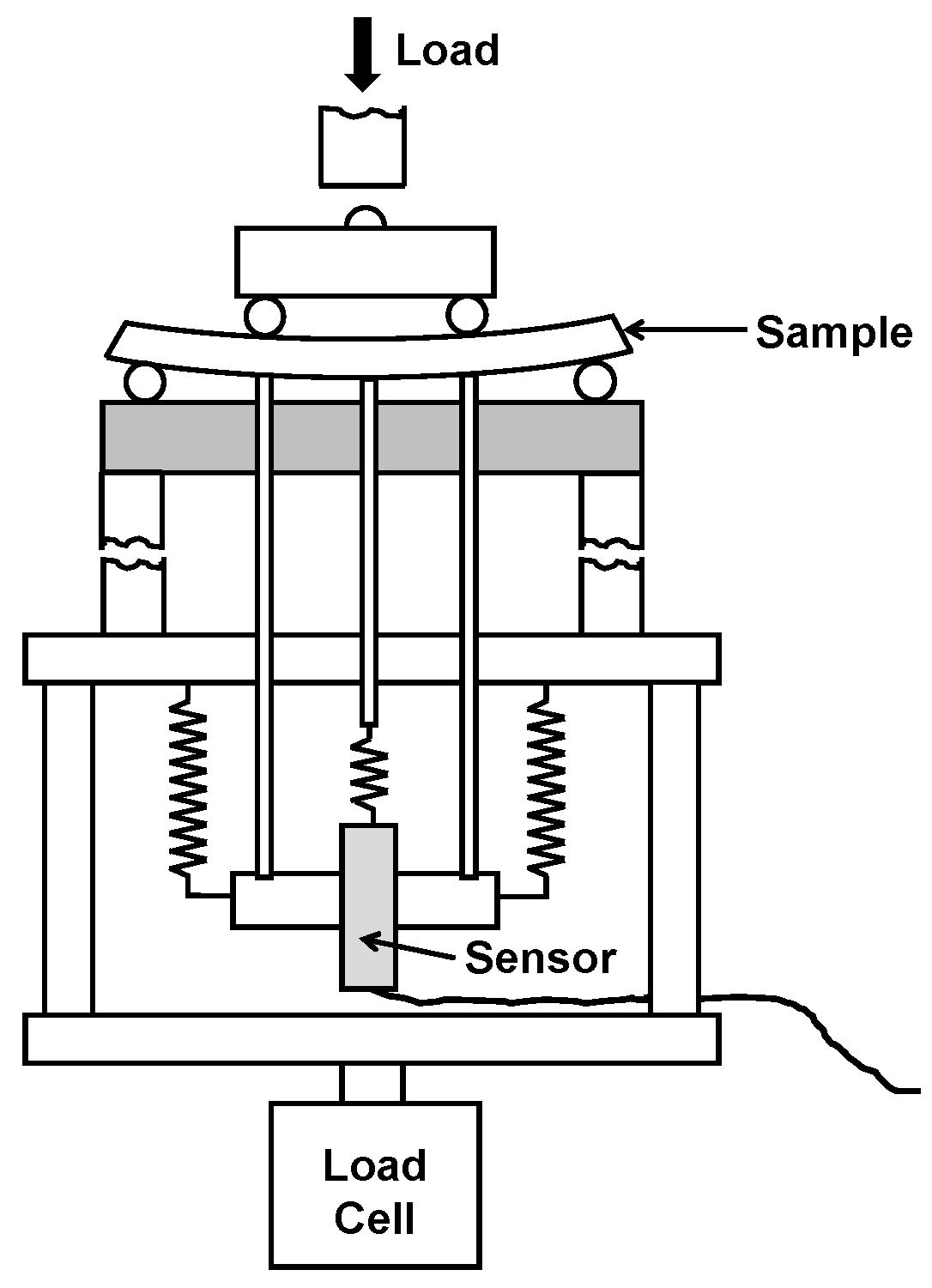
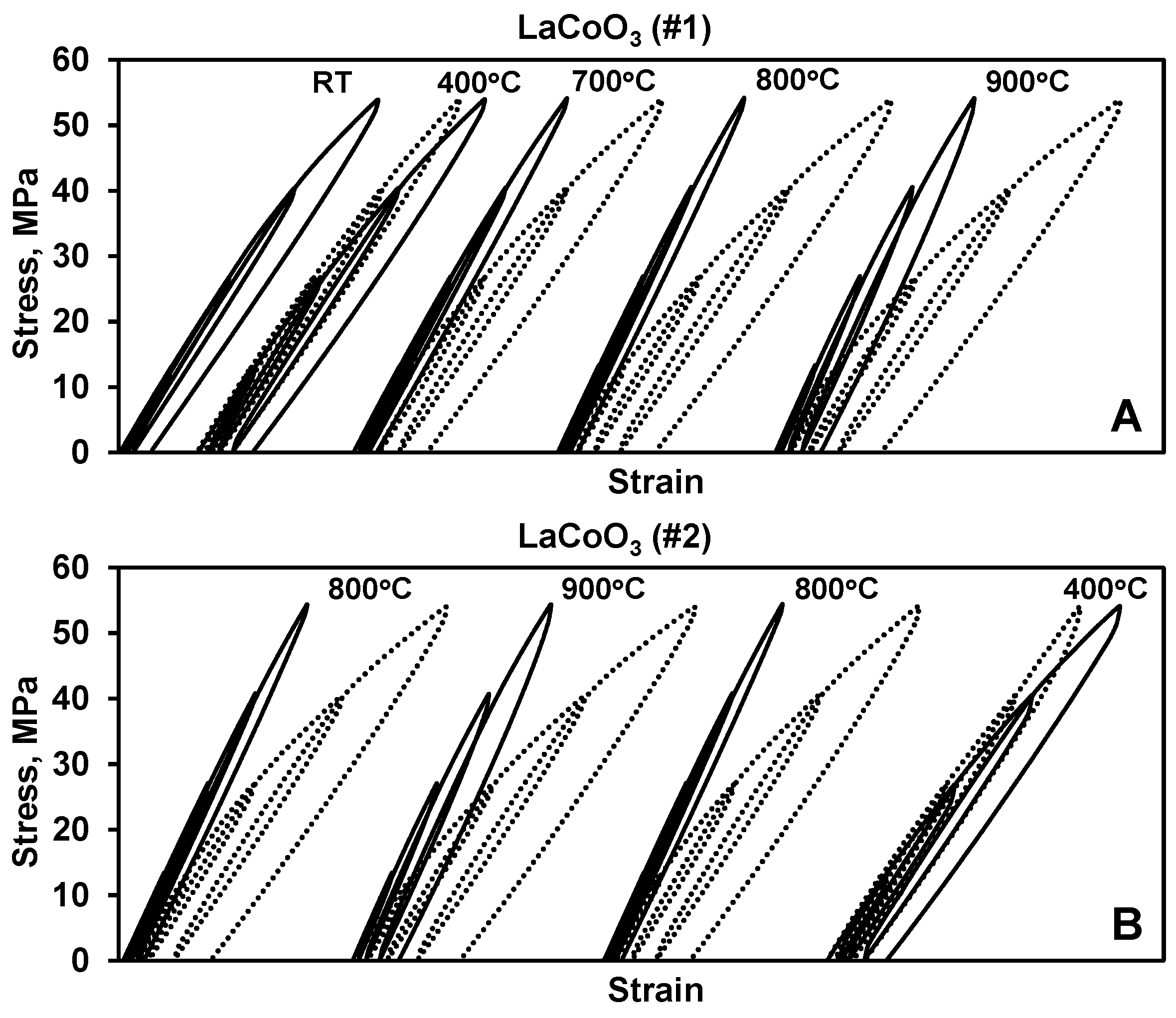
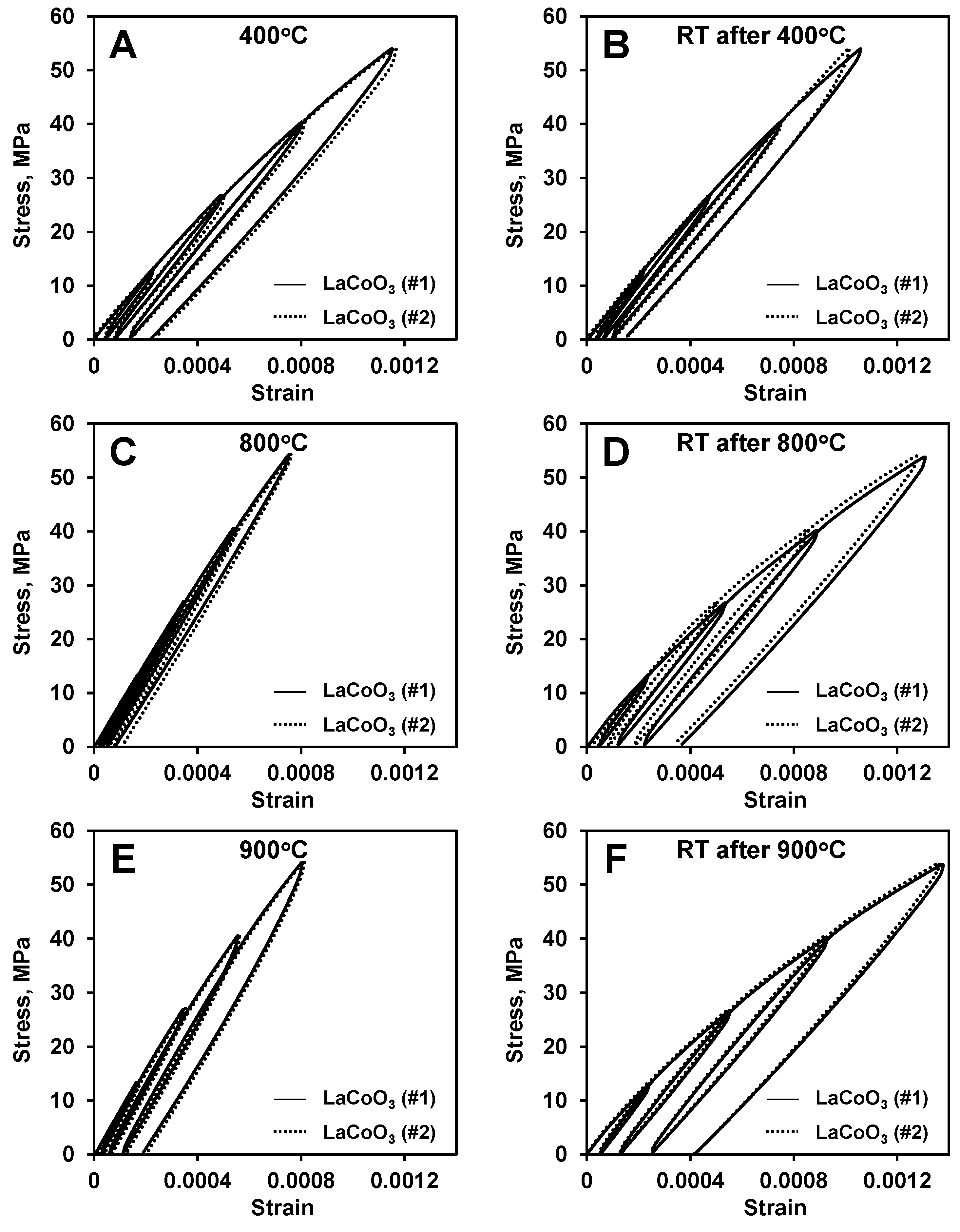
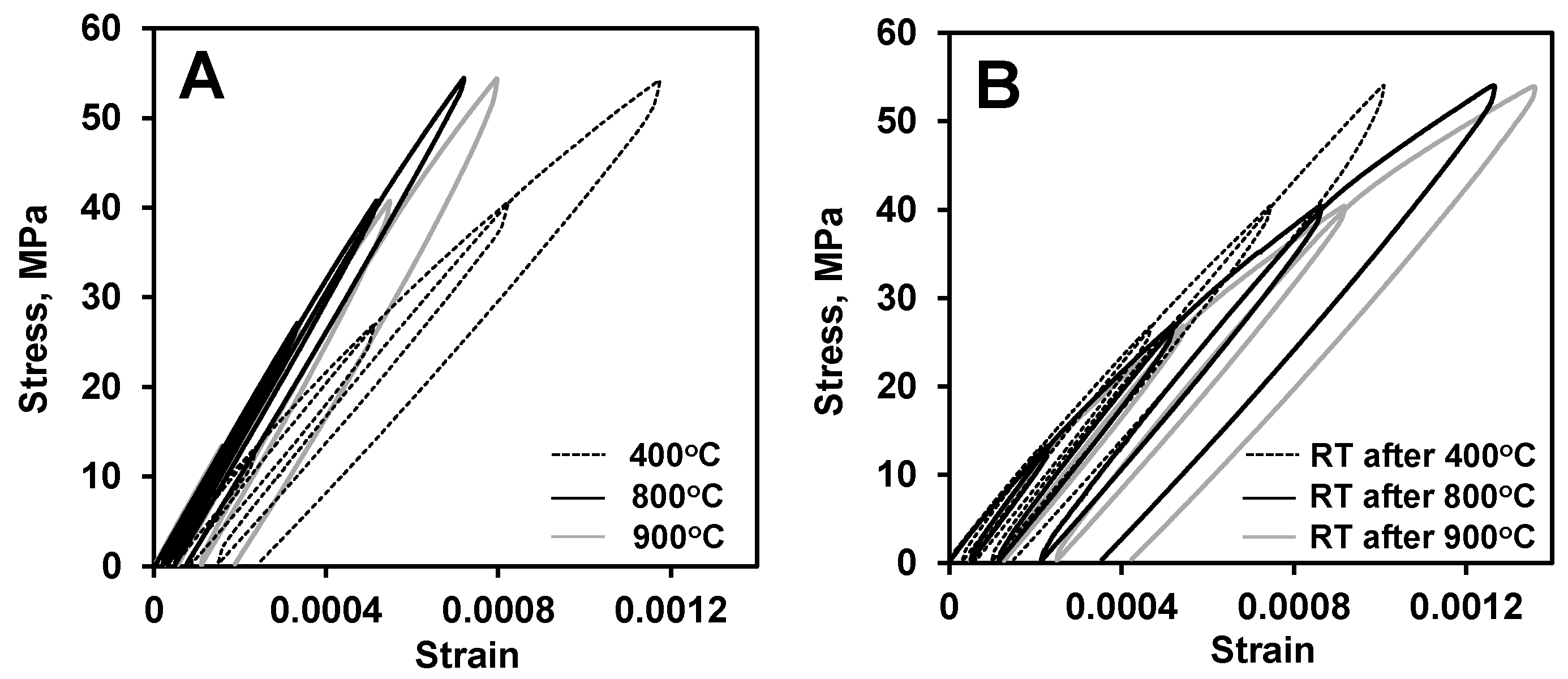
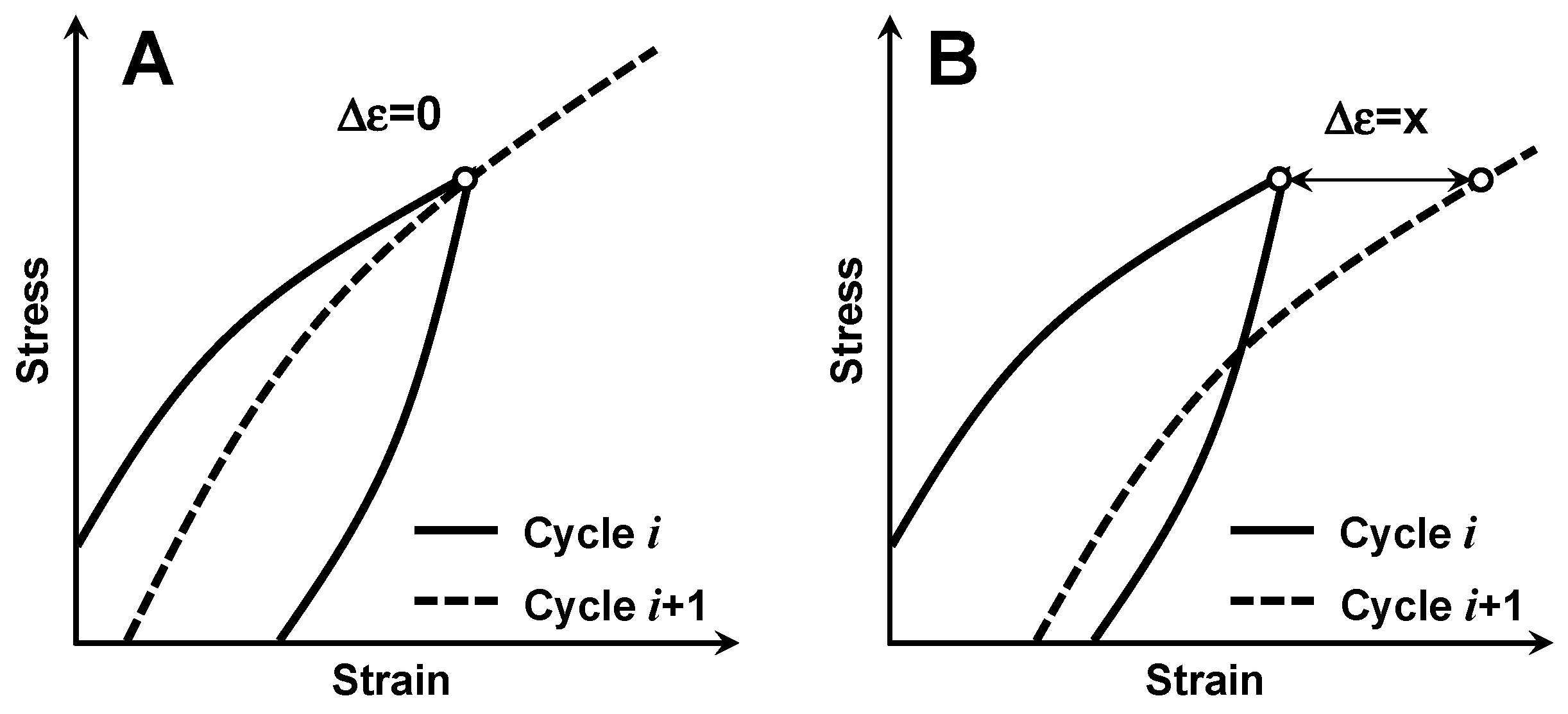
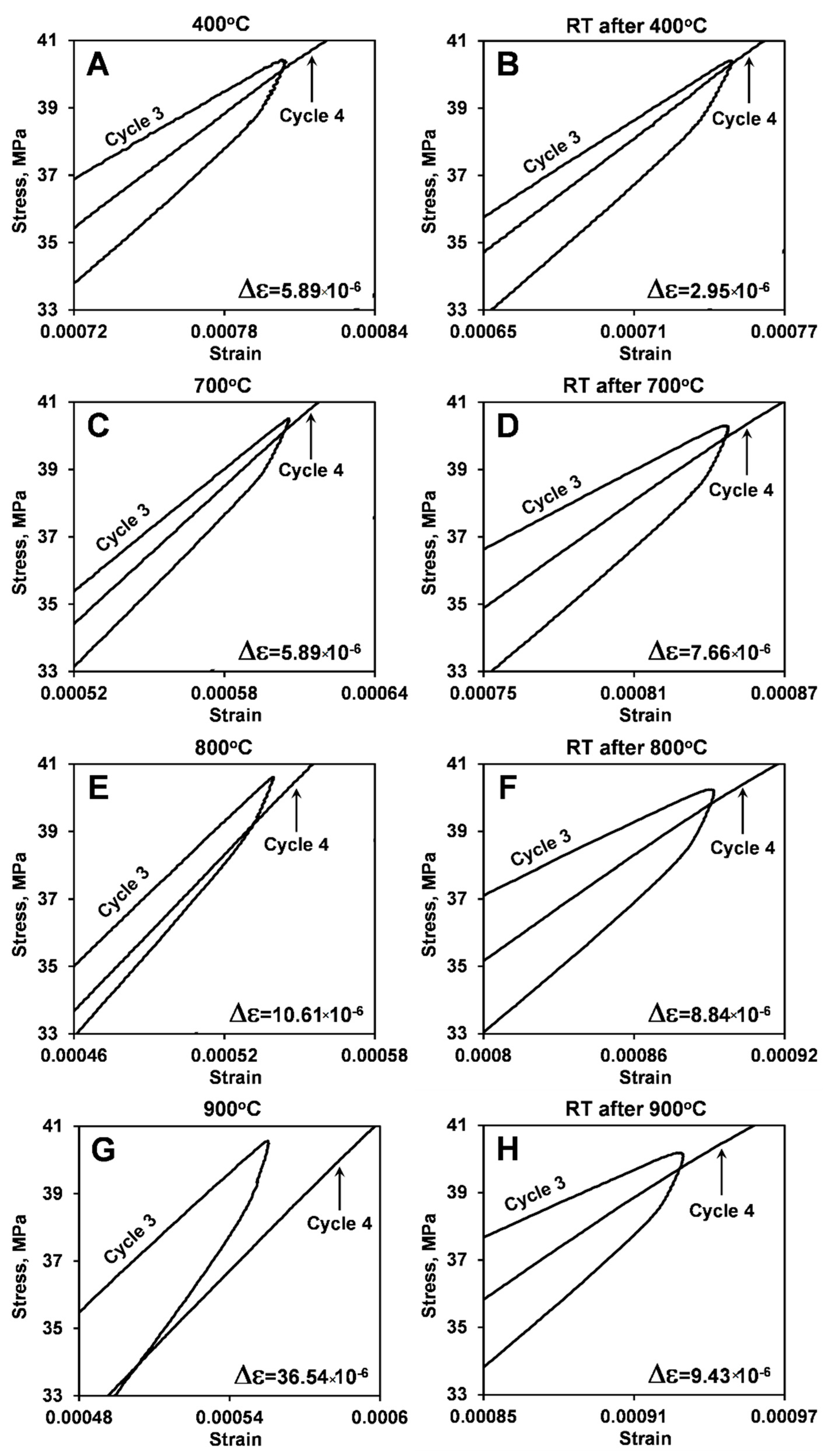
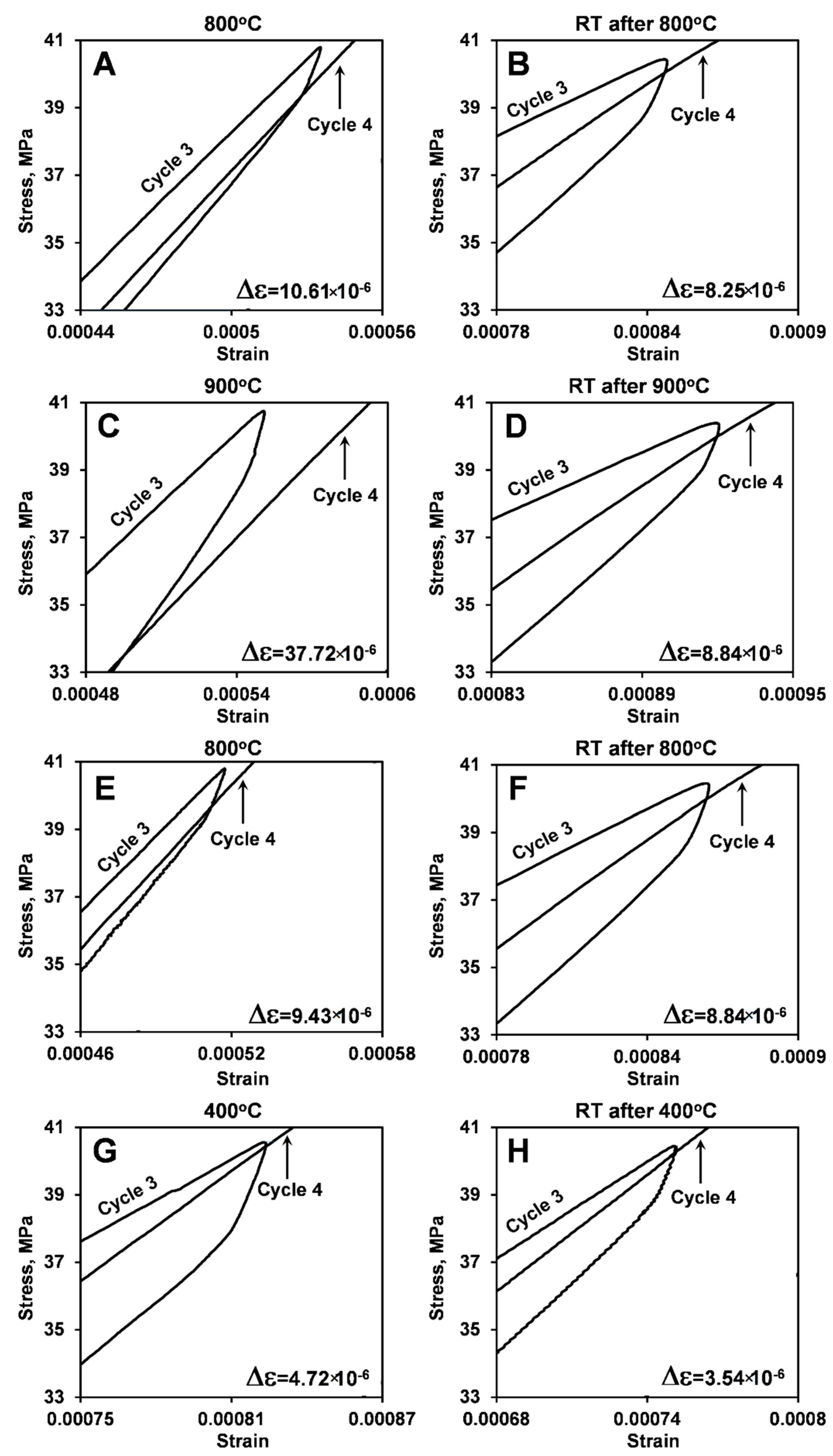

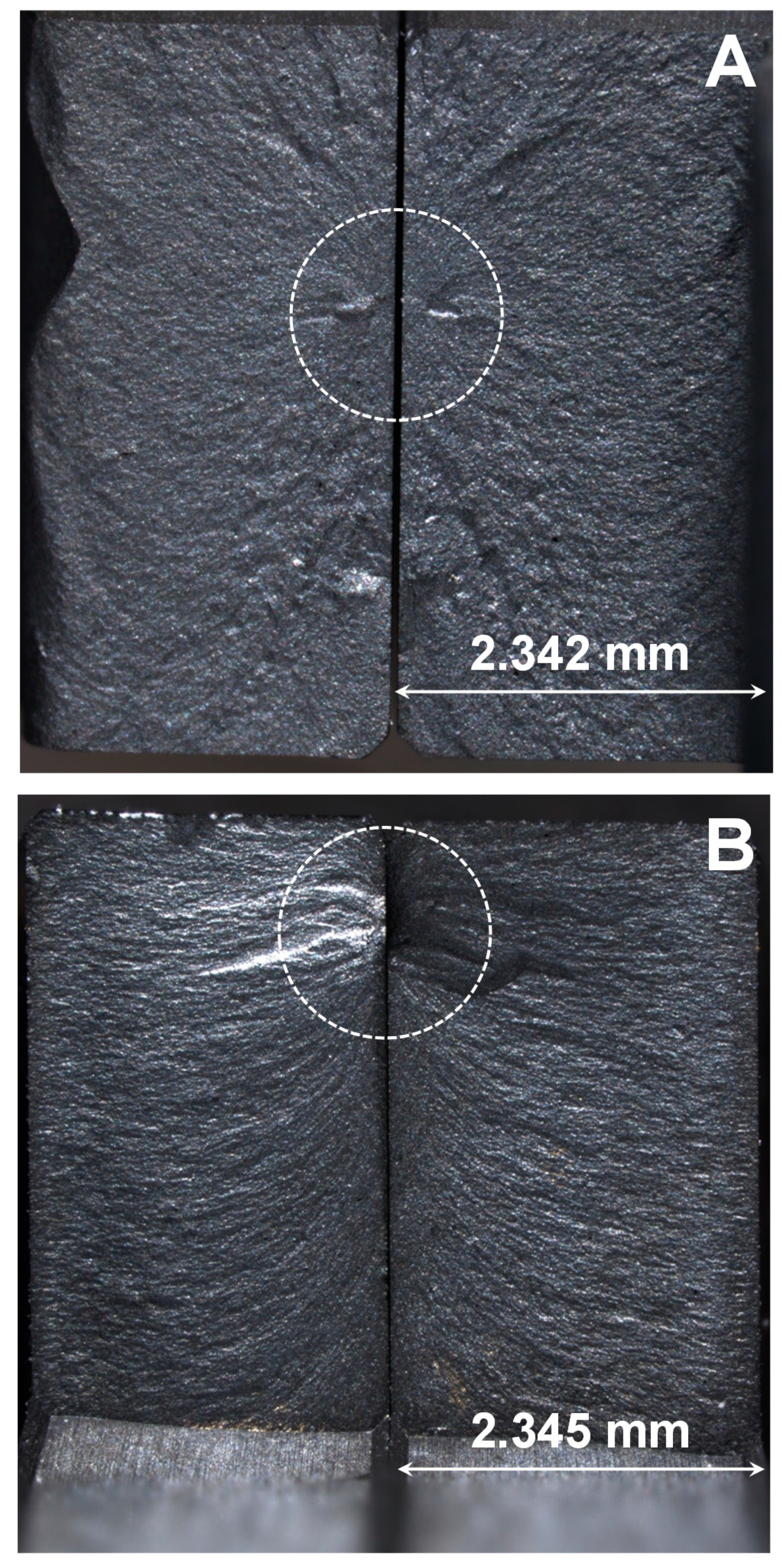
| Sample # | Temperatures of Cycling Loading |
|---|---|
| 1 | RT–400 °C–RT–700 °C–RT–800 °C–RT–900 °C–RT |
| 2 | 800 °C–RT–900 °C–RT–800 °C–RT–400 °C–RT |
| 3 | 800 °C |
| Sample # | T, °C | E, GPa | Hysteresis Loop Area, kPa | ||||||
|---|---|---|---|---|---|---|---|---|---|
| Cycle | Cycle | ||||||||
| 1 | 2 | 3 | 4 | 1 | 2 | 3 | 4 | ||
| 1 | RT | 67 | 69 | 68 | 67 | 0.26 | 0.71 | 2.15 | 6.30 |
| 400 | 65 | 67 | 64 | 62 | 0.43 | 1.43 | 3.45 | 6.90 | |
| RT | 65 | 69 | 67 | 66 | 0.34 | 1.13 | 2.54 | 5.20 | |
| 700 | 73 | 75 | 76 | 75 | 0.22 | 0.70 | 1.61 | 3.30 | |
| RT | 66 | 69 | 67 | 66 | 0.46 | 1.82 | 4.32 | 8.60 | |
| 800 | 83 | 84 | 84 | 83 | 0.18 | 0.54 | 1.27 | 2.60 | |
| RT | 65 | 68 | 67 | 65 | 0.49 | 2.16 | 5.23 | 10.20 | |
| 900 | 87 | 90 | 90 | 91 | 0.24 | 0.94 | 2.45 | 5.10 | |
| RT | 64 | 67 | 67 | 64 | 0.52 | 2.30 | 5.79 | 11.60 | |
| 2 | 800 | 83 | 84 | 84 | 83 | 0.18 | 0.54 | 1.27 | 2.60 |
| RT | 64 | 68 | 67 | 65 | 0.32 | 1.53 | 5.24 | 10.50 | |
| 900 | 88 | 91 | 92 | 92 | 0.24 | 0.94 | 2.52 | 5.20 | |
| RT | 65 | 68 | 67 | 65 | 0.51 | 2.31 | 5.85 | 11.60 | |
| 800 | 85 | 87 | 87 | 87 | 0.18 | 0.52 | 1.17 | 2.40 | |
| RT | 66 | 71 | 68 | 64 | 0.50 | 2.08 | 5.12 | 10.00 | |
| 400 | 60 | 67 | 63 | 62 | 0.51 | 1.72 | 3.96 | 7.90 | |
| RT | 65 | 67 | 67 | 65 | 0.37 | 1.27 | 2.85 | 5.00 | |
| LaCoO3 Sample #1 | LaCoO3 Sample #2 | ||||
|---|---|---|---|---|---|
| T, °C | Δε at T | Δε at RT after T | T, °C | Δε at T | Δε at RT after T |
| RT | 2.95 ×10−6 | - | - | - | - |
| 400 | 5.89 ×10−6 | 2.95 ×10−6 | 800 | 10.61 ×10−6 | 8.25 ×10−6 |
| 700 | 5.89 ×10−6 | 7.66 ×10−6 | 900 | 37.72 ×10−6 | 8.84 ×10−6 |
| 800 | 10.61 ×10−6 | 8.84 ×10−6 | 800 | 9.43 ×10−6 | 8.84 ×10−6 |
| 900 | 36.54 ×10−6 | 9.43 ×10−6 | 400 | 4.72 ×10−6 | 3.54 ×10−6 |
| LaCoO3 Sample #3, 800 °C | ||||
|---|---|---|---|---|
| # Cycle | σmax, MPa | E, GPa | Hysteresis Loop Area, kPa | Creep Strain Shift Δε |
| 1 | 13.50 | 84 | 0.18 | 3.54 ×10−6 |
| 2 | 27.00 | 85 | 0.56 | 5.89 ×10−6 |
| 3 | 40.50 | 84 | 1.33 | 10.73 ×10−6 |
| 4 | 54.00 | 83 | 2.74 | 15.32 ×10−6 |
| 5 | 67.50 | 82 | 5.01 | 22.40 ×10−6 |
| 6 | 81.00 | 81 | 8.26 | 31.83 ×10−6 |
Publisher’s Note: MDPI stays neutral with regard to jurisdictional claims in published maps and institutional affiliations. |
© 2021 by the authors. Licensee MDPI, Basel, Switzerland. This article is an open access article distributed under the terms and conditions of the Creative Commons Attribution (CC BY) license (https://creativecommons.org/licenses/by/4.0/).
Share and Cite
Lugovy, M.; Verbylo, D.; Orlovskaya, N.; Reece, M.; Kuebler, J.; Graule, T.; Blugan, G. Effect of Loading and Heating History on Deformation of LaCoO3. Materials 2021, 14, 3543. https://doi.org/10.3390/ma14133543
Lugovy M, Verbylo D, Orlovskaya N, Reece M, Kuebler J, Graule T, Blugan G. Effect of Loading and Heating History on Deformation of LaCoO3. Materials. 2021; 14(13):3543. https://doi.org/10.3390/ma14133543
Chicago/Turabian StyleLugovy, Mykola, Dmytro Verbylo, Nina Orlovskaya, Michael Reece, Jakob Kuebler, Thomas Graule, and Gurdial Blugan. 2021. "Effect of Loading and Heating History on Deformation of LaCoO3" Materials 14, no. 13: 3543. https://doi.org/10.3390/ma14133543
APA StyleLugovy, M., Verbylo, D., Orlovskaya, N., Reece, M., Kuebler, J., Graule, T., & Blugan, G. (2021). Effect of Loading and Heating History on Deformation of LaCoO3. Materials, 14(13), 3543. https://doi.org/10.3390/ma14133543







